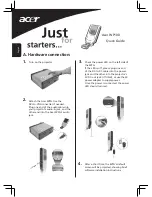External Memory Controller (EMC)
Symphony DSP56724/DSP56725 Multi-Core Audio Processors, Rev. 0
Freescale Semiconductor
21-91
21.5.2.3
UPM Cycles with Additional Address Phases
The flexibility of the UPM allows you to insert additional address phases during read cycles by changing
the AMX field, thereby turning around the bus during one pattern. The EMC automatically inserts a single
bus turnaround cycle if the bus (LAD) was previously high impedance for any reason, such as a read,
before LALE is driven and if LAD is driven with the new address. The turnaround cycle is not inserted on
a write, because the bus was already driven to begin with.
Bus contention could potentially still occur on the far side of a bus transceiver. It is the responsibility of
the designer of the UPM pattern to guarantee that enough idle cycles are inserted in the UPM pattern to
avoid this.
21.5.3
Interfacing to SDRAM
21.5.3.1
Basic SDRAM Capabilities of the External Memory Controller
The EMC provides one SDRAM machine for the external memory. Although there is only one SDRAM
machine, multiple chip selects (LCSx) can be programmed to support multiple SDRAM devices. Note that
no limitation exists on the number of chip selects that can be programmed for SDRAM. This means that
LCS[7:1] can be programmed to support SDRAM, assuming LCS0 is reserved for the general-purpose
chip-select machine (GPCM) to connect to Flash memory.
If multiple chip selects are configured to support SDRAM on the EMC, each SDRAM device should have
the same timing parameters. This means that all option registers (ORn) for the SDRAM chip selects should
be programmed exactly the same.
NOTE
Although in principal it is possible to mix timing parameters, combinations
are limited and this operation is not recommended.
All the chip selects share the same external memory SDRAM mode register (SDMR) for initialization, and
also share the EMC-assigned SDRAM refresh timer register (SRT) and the memory refresh timer prescaler
register (MPTPR), for refresh purposes.
For refresh, the memory controller supplies auto refresh to SDRAM according to the time interval
specified in SRT and MPTPR, which is:
This represents the time period required between refreshes. When the refresh timer expires, the memory
controller issues a refresh command to each chip select. Each refresh command is separated by one clock.
A refresh timing diagram for multiple chip selects is shown in
During a memory transaction dispatched to the EMC, the memory controller compares the memory
address with the address information of each chip select (programmed with BRn and ORn). If the
comparison matches a chip select that is controlled by SDRAM, the memory controller requests service to
the EMC SDRAM machine, depending on the information in BRn. Although multiple chip selects may be
Refresh Period
SRTx MPTPR PTP
[
]
(
)
System Frequency
--------------------------------------------------------------
=
Содержание Symphony DSP56724
Страница 22: ...Symphony DSP56724 DSP56725 Multi Core Audio Processors Rev 0 1 10 Freescale Semiconductor Introduction ...
Страница 52: ...Symphony DSP56724 DSP56725 Multi Core Audio Processors Rev 0 2 30 Freescale Semiconductor Signal Descriptions ...
Страница 112: ...Symphony DSP56724 DSP56725 Multi Core Audio Processors Rev 0 7 12 Freescale Semiconductor Clock Generation Module CGM ...
Страница 244: ...Symphony DSP56724 DSP56725 Multi Core Audio Processors Rev 0 14 6 Freescale Semiconductor Shared Bus Arbiter ...
Страница 246: ...Symphony DSP56724 DSP56725 Multi Core Audio Processors Rev 0 15 2 Freescale Semiconductor Shared Memory Shared Memory ...


















